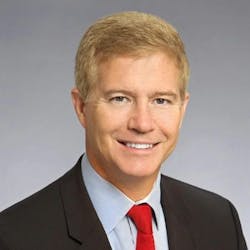Frank Harvey, CEO of Surescripts, recently spoke with Healthcare Innovation about a range of issues, including a recent acquisition, the potential for pharmacists to play a larger role on primary care teams, and why Surescripts Health Information Network LLC is applying to become a Qualified Health Information Network (QHIN) under the Trusted Exchange Framework and Common Agreement (TEFCA).
Harvey succeeded Tom Skelton as CEO in 2022. A pharmacist himself, Harvey has held leadership positions in the healthcare technology, pharmacy and pharmaceutical sectors. He joined Surescripts from ATLS Investments LLC, where he led private equity investing in healthcare technology companies.
Healthcare Innovation: Could you talk a little bit about how the role that pharmacists play in the healthcare ecosystem is evolving?
Harvey: There are two major things that we're facing. One is the silver tsunami. Right now we have 58 million people aged 65 and older. By 2030, it's estimated that we'll have 70 million people. By age 65, 80 percent of people have at least one chronic condition and 60 percent of people have two chronic conditions. In addition, you have the burnout that clinicians are feeling because of the pandemic — but it's not just the pandemic. It's all this administrative burden that we've put on physicians, pharmacists and the entire care team. It's estimated that 20 percent of physicians plan to retire in the next two years. So you've got an aging population, and you've got an estimated shortage of about 135,000 primary care physicians by 2034.
We're not replacing them rapidly enough. So that really forces us to look at the care team structure — how they work together, and who can pick up some of that slack. When you look at the care team, pharmacists have the scope of training to pick up a lot of that first level of primary care. They want to do that and it will help with some of the pharmacist burnout we've seen, too. Pharmacists are burning out just like physicians because they're focused on the menial tasks that they should be removed from so they can focus on more of the primary care-focused areas.
HCI: In many areas, the independent pharmacies have largely disappeared and the large retail chains dominate. Can the pharmacists in those retail environments take on this role? And are those chains interested in seeing their pharmacist take on that role?
Harvey: Absolutely. I think if you look at all the major chains, they're already acknowledging the need for the pharmacist job to evolve, including doing immunizations that we did such a great job of during the pandemic. We have to become chronic care managers, which means we have to let pharmacists do that lower level of primary care to relieve some of that burden from the physician. There’s really a three-legged stool. One is technology. That’s the role of Surescripts, making sure we've got the right clinical information in the hands of the pharmacist or the physician when they're making those care decisions. A pharmacist or a physician doesn't have all day to read through a 300-page medical chart, so our technology helps boil that down to a summary.
Another leg of the stool is the reimbursement policy. We have to amend reimbursement policy both at the CMS level and at the health plan level to pay pharmacists for this additional activity. There's got to be compensation for that or they can't afford to do it.
The third piece is we need legislative changes across the U.S. and in the states. During the pandemic, HHS gave pharmacists broader privileges and they extended that through December of 2024. I think we need to make those privileges go on from there. Because states are responsible for licensure and monitoring, a lot of the states have to pass legislation to recognize the scope of the pharmacists’ training and empower them to provide those functions. The studies we've done have shown that physicians are in favor of a pharmacist doing more as part of a collaborative care team and it really opens up their ability to focus on the things that are at the top of their their training.
HCI: Surescripts does surveys of pharmacists about their top challenges, and a recent report said they spoke about the need for electronic access to clinical information, benefit eligibility information, and electronic prior authorization. How difficult is it to gather that information and present it to them at the point of care?
Harvey: It's not that difficult at all. As a matter of fact, we do that right now through their pharmacy operating systems. I think one of your articles in the last day or so was about some statistics about the burden of prior authorization. It's one of the most burdensome thing for the physician's office. It's not only administratively burdening for the physician, but it also delays care for the patient.
We have an electronic prior authorization solution that's proactive. So when the physician is writing the prescription, our solution goes out immediately rather than having to take two or three days to go through a process. In addition, with the Surescripts real-time prescription benefit product, the physician pulls up what medication he wants to give that patient, and it shows him therapeutic alternatives. It shows him and the patient what their benefit covers. It shows them what the costs will be at retail. Almost 20 percent of patients will go to the pharmacy, and then the pharmacy has to call back to say ‘hey, this patient can't afford this. What can you do? Can you change it?’ You get that taken care of right at the physician’s office.
HCI: Surescripts recently bought a company called ActiveRadar. Can you explain what was attractive about that company?
Harvey: We looked at all the companies out there and we really felt like ActiveRadar had the best therapeutic alternative solution available. All the health plans and all PBMs have to have a therapeutic PMT committee that decides what drugs are interchangeable. It’s a really expensive proposition, particularly for smaller regional plans. Through their technology, ActiveRadar sort of does that work for for the plans and for the PBMs. That allows them to say, ‘Okay, I'll just use yours rather than having to employ all these additional folks to do it.’ It creates more consistency across all the different plans as well.
If you look at real-time prescription benefit, making sure the right therapeutic alternatives are presented as a part of that solution is important as well.
HCI: Surescripts Health Information Network just announced it's applying to be a QHIN under the TEFCA framework. Who would be logical partners to be sub-participants under the TEFCA framework?
Harvey: The pharmacies, the labs, PBMs, the health plans. We’re the largest interoperability company in the country already. We did 22 billion transactions last year. Only about 2.35 billion of those are actually prescriptions. The rest is all the clinical data.
We are very confident that we can serve everyone across the spectrum of healthcare. And if you think about the Qualified Health Information, Networks in TEFCA, it really does become a network of networks, as you will, because each one is going to be successful bringing in people who will be their customers. We really think the team at ONC has done a wonderful job. If you think about what's the importance of this, it comes back to the patient's ability to make sure they're getting the right treatment when they're in front of a care provider, because with an incomplete medical record, they’re never sure that the right decisions are being made.
HCI: In September, the company named Lynne Nowak, M.D., its first chief data and analytics officer. Why did Surescripts see a need for that role? And what are some of the things that she and her team are working on?
Harvey: Well, a great example is that ActiveRadar is going to be a part of her organization. We know the data has power to make sure that we’re focused on the things that could be improving the quality of care, improving patient safety and lowering the cost of care. When you have 22 billion transactions, there’s so many things that can come out of that, looking at that information, trying to identify those things that are best for the patient. We believe there's a significant opportunity for Lynne and our data scientists to really build out the things that will support those core parts of our mission.
HCI: Looking ahead to 2024, are there any other plans you want to talk about?
Harvey: We're focused on trying to take the administrative burden away from the care providers because we really do see it as a crisis when you see the pharmacists taking turns going on strike, if you will, because of their working conditions and they're not able to focus on the things that they want to. So our objective is to look across all of the things we provide and continue to perfect them. In the last four years, we've improved the quality of e-prescriptions by over 200 percent. We are working on making sure that our clinical direct messaging product is out there and pervasive through healthcare so the pharmacist can message the physician, the physician can message the pharmacist right in workflow, removing the administrative burden of having to send a fax. Healthcare is probably one of the last bastions of the fax machine. We would really like to see an end of that fax machine and we believe a lot of our technologies will be helpful in that end.
HCI: Are there some ways that all this excitement and development around artificial intelligence and large language models can apply to the work you guys do?
Harvey: People sometimes mix up machine learning and generative AI. We've been using machine learning since the very beginning inside our products. We're starting to look at generative AI. We do think there are some things we can utilize it for. However, I'll say we're being really cautious because there are still a lot of unknowns about generative AI and it has hallucinations. When you're dealing with the patient's record, you can't have hallucinations. So we're looking at it, we're testing it, doing a lot of pilot things around it, but until we're absolutely sure that it's what it needs to be, we’re not going to roll it out into our overall portfolio.



